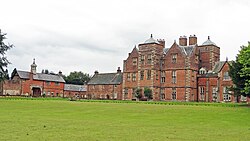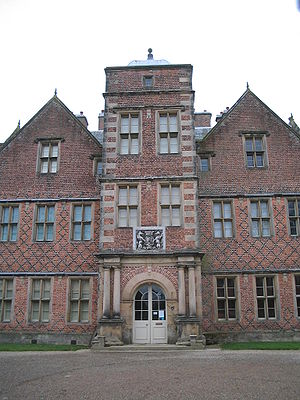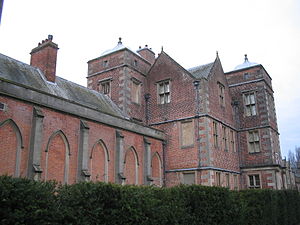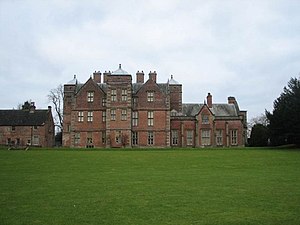Kiplin Hall
| Kiplin Hall | |
| Yorkshire North Riding | |
|---|---|
 The west front of Kiplin Hall | |
| Location | |
| Grid reference: | SE27459749 |
| Location: | 54°22’20"N, 1°34’45"W |
| Village: | Kiplin |
| History | |
| Built 1622–1625 | |
| Jacobean | |
| Information | |
| Owned by: | Kiplin Hall Trust |
| Website: | https://kiplinhall.co.uk/ |
Kiplin Hall is a historic house in the North Riding of Yorkshire. It is a Jacobean house, built in the style of the age, and a Grade I listed building.[1]
The house stands close to the River Swale in the Vale of Mowbray. It is rich in education, in architecture and art, a museum of history, a gallery and which provides a biographical record of its past owners.[2]
The nearest villages are Scorton, Great Langton and Bolton-on-Swale.
History
In the Middle Ages, the Kiplin Estate was owned by Easby Abbey. Following the Dissolution of the Monasteries, the land passed to John Scrope, 8th Baron Scrope of Bolton. His son, Thomas Wharton was a loyal servant of the Queen Mary, and so fell out of favour after her death and he sold the estate to the Calvert family in 1559.
The current house was built at some time during the period 1622–1625 for George Calvert,[3] Secretary of State to King James I, who later became first Lord Baltimore and founded the Colony of Maryland in America. Calvert was sympathetic to Roman Catholics, as his father had been persecuted for recusancy, and he himself went over to the Roman religion towards the end of his life
Initially built as a hunting lodge, Kiplin Hall was a slightly rectangular building fashioned of red brick with diamond patterning known as diapering formed from blue-black headers incorporated into the brick bond. Kiplin had four towers, which unusually were not placed at the corners of the structure but at the centre of each of the four walls, the north and south towers containing staircases whilst the east and west comprised part of the rooms in which they were contained. At the summit of each tower is an ogee dome.[2][3][4]
Eighteenth century
In 1722 Charles Calvert, 5th Baron Baltimore, found himself in financial difficulties and sold the Kiplin estate to his mother's second husband (his stepfather), Christopher Crowe, for £7,000. Crowe had been British Consul in Leghorn, Italy, and enjoyed the lucrative contract for supplying the British naval fleet with wine and olive oil. Combined with his activities in collecting antiquities for the British aristocracy his wealth and power grew. He found the hundred-year-old house lacking comfort - the Calverts had never lived there - and set about a renovation programme including the addition of a grand staircase, fireplaces and dado rails as well as a servants' wing to the north (much of which was demolished in the 1970s). Crowe enlarged the Kiplin estate to some 4,000 acres.
Nineteenth century
In 1817, Christopher Crowe's great-granddaughter Sarah Crowe married John Delaval Carpenter, fourth (and final) Earl of Tyrconnell of the fourth creation. The first Earl's daughter had been mistress to a Prince[5] and Almeria Carpenter's portrait by Angelica Kauffmann is displayed in the dining room.
Lady Tyrconnell inherited Kiplin the following year and in 1819 commissioned the architect P. F. Robinson to build a wing to the south. Built in 'Wyatville's Gothic', this room was initially a Gothic-style drawing room. After 30 years of marriage the couple had one daughter, Elizabeth, who died the day she was born. They were now faced with the problem of to whom they might pass the Hall and estate on their own deaths. Predeceased by her husband, in 1868 Sarah died, leaving the estate to John Carpenter's first cousin twice removed, Captain Walter Cecil Talbot.[6]
Talbot was the second son of Henry John Chetwynd-Talbot, 18th Earl of Shrewsbury and inherited Kiplin Hall on condition that he legally change his surname to Carpenter, marry a Protestant and submit to a seven-yearly examination of his faith by a team of Anglican clergy. He accepted these conditions and inherited the estate in 1868, eventually taking up residence in 1887. He instructed the architect William Eden Nesfield to add a further floor to the Gothic-style drawing room and the space was converted to a Jacobean-style library. His second wife, Beatrice de Grey, was prominent in the Arts and Crafts movement and the Hall contains some beautiful works by local craftsmen in this style. Eventually he was promoted to Admiral. He died on a trip to London in 1904 and his only daughter, Sarah Marie Talbot Carpenter, inherited.[7]
Twentieth century
Sarah Talbot Carpenter married Christopher Hatton Turnor from Stoke Rochford in Lincolnshire in 1907 but they had no children. The couple never resided at Kiplin and the house was let. Five sales of land reduced the estate to 120 acres and disposed of many of the tenant farms, land and cottages that had contributed to its running. The estate entered virtually a century of decline. Much of the nearby local landscape has since been extensively quarried for sand and gravel extraction.[7]
In 1937 Sarah Turnor shared ownership of the Hall with her first cousin, Bridget Elizabeth Talbot, daughter of the Admiral's youngest brother, Alfred. Miss Talbot had happy memories of visiting the estate in her childhood and had previously campaigned to save the Ashridge Estate near her home in Little Gaddesden (near Berkhamstead).[2] In an attempt to capitalise on the connection with the founder of Maryland, she advertised the Hall as a guest house to American visitors and as a conference centre. From 1937 until 1958 she tried to interest the National Trust in taking over Kiplin but it remained largely indifferent, considering the Hall of little historical significance and insisting that the north and south wings, which were later additions, would have to be demolished.[2][7]
During the Second World War the Hall was requisitioned by the Royal Air Force and used as a maintenance unit, storing and supplying armaments for local airfields at RAF Catterick, RAF Croft and RAF Middleton St George.[8] In addition some of the rooms were converted to flats for officers’ use and it was used by men from the 1st Battalion of the East Lancashire Regiment as a place to recover after being rescued at Dunkirk.[8]
In February 1968 Miss Talbot set up the Kiplin Hall Trust, its purpose being to hold Kiplin Hall and its appurtenances in trust permanently to preserve them for the benefit of the nation as a place of beauty and historical and architectural interest. Bridget Talbot died in November 1971, leaving the contents of the Hall to the Trust, which still cares for the Hall and estate today.[2][7]
The hall today
A permanent exhibition in the hall charts the founding of Maryland by George Calvert and the lives of the families who lived in Kiplin Hall through the centuries.[2][3]
In 1986 the University of Maryland, with funding from the state of Maryland, opened the University of Maryland Study Center at Kiplin Hall, established a resource "built out of what was originally a stable house and blacksmith’s shop." It is open for students in the School of Architecture, Planning and Preservation.[9]
Pictures
 |
 |
 |
Outside links
| ("Wikimedia Commons" has material about Kiplin Hall) |
References
- ↑ National Heritage List 1315476: Kiplin Hall (Grade I listing)
- ↑ 2.0 2.1 2.2 2.3 2.4 2.5 University of Maryland School of Architecture, Planning & Preservation (2012). "About Kiplin Hall". University of Maryland School of Architecture, Planning & Preservation. http://www.arch.umd.edu/preservation/resources/study_abroad/about_kiplin_hall.cfm. Retrieved 29 August 2012.
- ↑ 3.0 3.1 3.2 Kiplin Hall (2012). "The Builder and the Building". Kiplin Hall. http://www.kiplinhall.co.uk/the-house/. Retrieved 29 August 2012.
- ↑ The National Archives (2009). "Records of Kiplin Hall". The National Archives, Kew, Surrey. http://www.nationalarchives.gov.uk/a2a/records.aspx?cat=2827-kh&cid=0#0. Retrieved 29 August 2012.
- ↑ Charles Watkins; Ben Cowell (2012). Uvedale Price (1747-1829): Decoding the Picturesque. Boydell Press. pp. 36–37. ISBN 978-1-84383-708-4. https://books.google.com/books?id=9FK1kzJCIhEC&pg=PA36.
- ↑ Kiplin Hall (2012). "The Carpenters – Kiplin in the 17th century". Kiplin Hall. http://www.kiplinhall.co.uk/the-families/the-carpenters. Retrieved 29 August 2012.
- ↑ 7.0 7.1 7.2 7.3 Kiplin Hall (2012). "The Talbots – Kiplin in the 17th century". Kiplin Hall. http://www.kiplinhall.co.uk/the-families/bridget-talbot. Retrieved 29 August 2012.
- ↑ 8.0 8.1 "When duty called for Kiplin Hall". Heritage Lottery Fund. https://www.hlf.org.uk/about-us/media-centre/press-releases/when-duty-called-kiplin-hall. Retrieved 9 October 2018.
- ↑ University of Maryland School of Architecture, Planning & Preservation (2010). "The University of Maryland Study Center at Kiplin Hall". University of Maryland School of Architecture, Planning & Preservation, College Park, Maryland. http://www.arch.umd.edu/preservation/resources/study_abroad/. Retrieved 29 August 2012.
